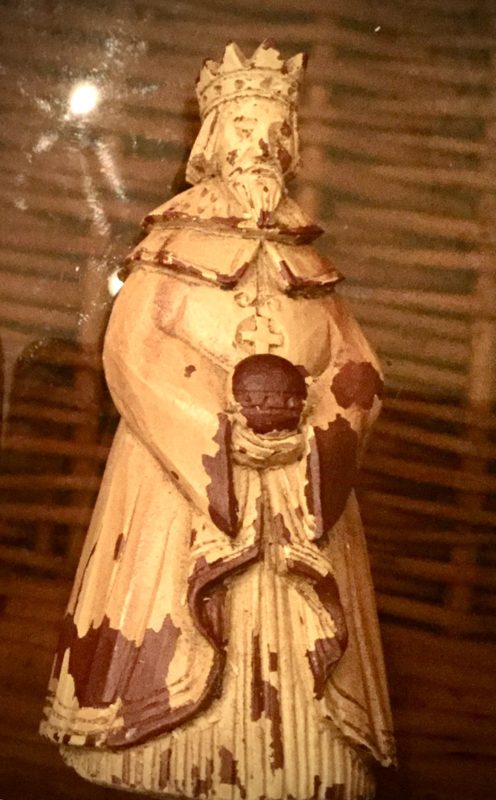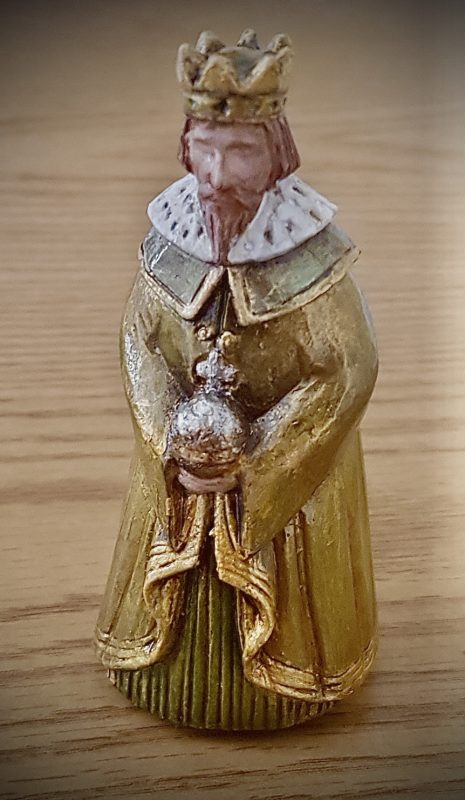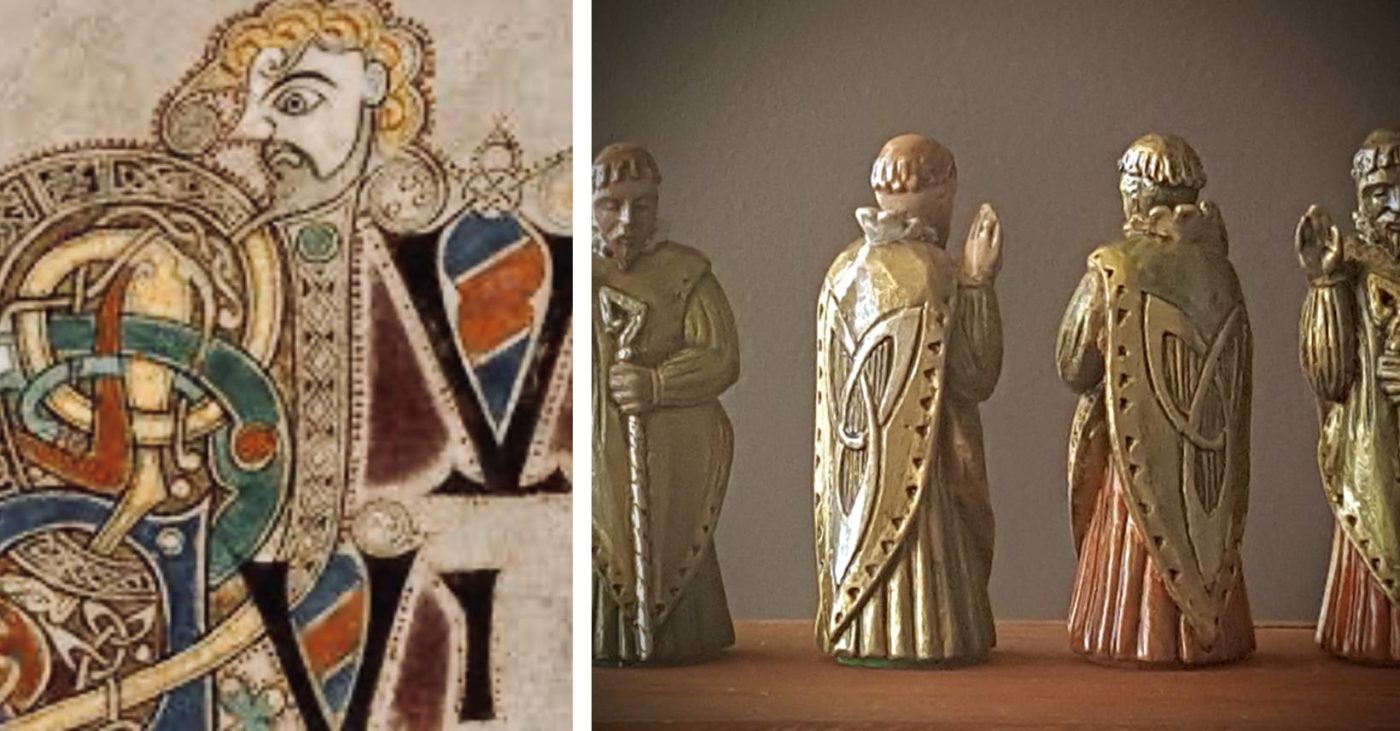Chess Set
THE KNOTTY CELTS (TRIQUETRUS HIBERNIA)
It’s in unusual circumstances that I sit here today and write this month’s Chessay. Toronto, where we are based, is virtually in lock-down due to the pandemic caused by the C-19 virus that is running rampant through so many parts of the world. What would normally be a day of celebration for me as I am of Irish descent (today is March 17th – St. Patrick’s Day) has been greatly dampened and replaced by an atmosphere of eerie quietness and concern. The streets are mostly empty, restaurants and pubs are all closed, as are public buildings, libraries, schools, sporting venues (including chess clubs), shopping centres, and all tourist attractions. Like many thousands of people around the globe, we are observing what is called ‘voluntary self-quarantine,’ keeping our close friends and family safe by remaining at home as much as possible until this devastating virus has been contained – and we all pray that this will be sooner rather than later and hope that you and yours remain safe and healthy during these worrying times; bringing to mind the old British adage; ‘Keep Calm and Carry On!’ – as life must indeed go on.

On that note, last week I promised a more in-depth piece on a set of Irish chessmen that were recently listed in our GALLERY and what better day to do that than on Saint Patrick’s Day! The pieces are figurative, heavy in hand and robust, formed from some type of dense brown resin and they came into my possession last summer, arriving in excellent condition overall – apart from the antiqued paint finish, which flaked off onto the fingers when handled (I don’t believe any primer or other adhering agents were used prior to painting).

Being a gentleman, the dealer informed me of this defect prior to purchase, but revitalizing these old warriors is my passion! My initial idea being to photograph the pieces individually, strip off the old paint and replicate the original finish – a basic paint technique I’m very familiar with. However, once the pieces came to hand I had a change of mind, as I was fascinated and impressed with the detail and workmanship which had gone into each piece. Questions then arose.
What characters from Irish history did these miniature figurines represent? What exactly were the kings holding so proudly in their hands? And what was that intriguing emblem on the shields of the knights, above the ‘castle’ door and also on the back of the bishop’s robe? In fact, it was the bishop that first struck me as being somewhat familiar, the crook, or ‘crozier’ he was holding was very similar to the one held by Saint Patrick in many representations I’ve seen of him over the years. Therefore, if the bishop represented St. Patrick, then who could the king and queen be? The queen certainly doesn’t look, well, too queenly …
Fortunately, we have very good friends here in Toronto (our wonderful neighbours, the O’ Toomeys!) originally from County Cork, Ireland, who almost immediately suggested after informing them of the Cork origins of the set (some of the bases carried the stamp; “designed and produced by Mercier Press, Cork, Ireland”), Saint Finbarr as the most likely candidate for the king, the patron saint of Cork, no less! And for the queen, Saint Brigid of Kildare, a nun who lived during the 5th century and was famous for her miraculous cloak! The life of Brigid is well-documented by the Irish chroniclers, one claiming that her mother was a Pict slave named Brocca, who had converted to Christianity and been baptized by none other than the bishop of this set, the legendary Saint Patrick! See the chronicle Bethu Brigte (unknown author).
Of the two suggestions, I believe Saint Brigid to be absolutely spot-on. The cloak is the foremost feature of the piece, which envelopes her frame almost completely and has an interesting yarn behind it, my own version of which I shall relate here.
The Miraculous Cloak of Saint Brigid
There are many versions of the legendary tale of Brigid’s Cloak, which centres around the ‘miracle’ of how the nun came about the land on which she built her convent in County Kildare circa 470 (sadly razed to the ground during the 12th century).
The yarn goes thus: finding the ideal spot for her future convent beside a freshwater lake with a forest on one side and fertile farming land on the other, the poor nun approached the King of Leinster (chronology suggests Crimthann mac Ennai, reigned circa 458-483) and pleaded for the land to be given to her and her followers to serve God. The pagan king, however, was unmoved and laughed off the request. Unperturbed, Brigid and her brigade prayed that the king would eventually find God and have a change of heart. A few days later she approached the king once again, this time requesting that he grant her “as much land as my cloak can cover.” Observing the size of the garment, the king let out a loud guffaw and granted her ridiculous request – and now the truth ‘stretches’ a little (pardon the pun).
Brigid then asked the king and his court to accompany her to the nearby lake and pastures, instructing three sisters to help her by each grasping a corner of the cloak and to walk in opposite directions, north, east, south, and west. The king laughed once more, but as the sisters walked the cloak grew and grew eventually covering several acres, enough land to build her convent and also a monastery! The king and his courtiers were amazed at this miracle and realized that Brigid was “truly blessed” by God. The land was formally granted to Brigid and her followers and the king became one of her greatest patrons, providing her with workers, money and other gifts. Shortly after this ‘miracle’ the king sought the services of the aforementioned Saint Patrick, who duly baptized him in the waters of the lake, becoming one of the first Christian kings of Ireland.
The Brigidine Sisters of Ireland still exist to this day. The various Irish and Scottish place names called Kilbride are the Anglicized form of the Old Gaelic ‘kil brighde’ (Church of Brigid). In the chronicle, Bethu Brigte, it gives Brigid’s father as Dubthach, a chieftain of Leinster. It seems more likely that he may have been somehow involved in acquiring the land from King Crimthann, just my two pennies worth …

The question now begs – could the king in this Irish set be the same king mentioned in the tale above? A distinct possibility, of course, as are several other famous Irish kings of old. To me, however, it makes more sense to the overall design of the set that the bishop, queen, and king would all be well-known Irish saints – and St. Finbarr (finn barr in Old Gaelic means ‘bright-hair’), the patron saint of Cork, makes a perfect candidate! He stands in prayer, eyes closed with long red hair, caressing the symbolic ‘globus cruciger’ (cross-bearing orb), holding the weight of the Christian world in his hands, so to speak, the crucifix attached to the orb symbolizing the spread of Christianity throughout world – a symbol closely associated in medieval art with popes, angels, and saints.

Right; Backsides of the Bishops
Speaking of symbols, we now come to the intertwining design found on the shields of the foot soldiers and once again my Irish friends quickly pointed me in the right direction, “it’s a trinity knot!” they yelled in unison. Once again they were spot on. Also known as a ‘triquetra’ from the Latin triquetrus, meaning a ‘three-cornered’ object, the unbroken knot design signifies an ‘eternal bond’ (in this case, a ‘brotherhood’) and first appeared in Irish art culture during the 7th century, and like chess, its murky origins are the cause of much debate as similar symbols have also been found in India and the Middle East dating back many thousands of years. A debate we’ll steer clear of here. In modern times it is used quite frequently in traditional Celtic marriage ceremonies as a symbol of a couple’s everlasting love – and on that eye-wateringly lovely note I will bid you farewell.
I hope you enjoyed our little sojourn through Irish history. Keep safe and germ-free everyone. Until next time. Check you later!
Copyright The Chess Schach, 2020. All rights reserved.
